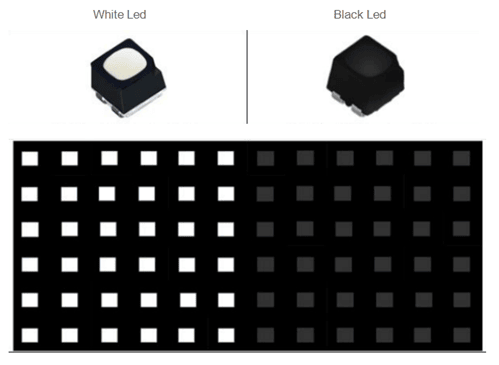Analysis of the Advantages of Black LED, Compared with White LED
Views: 7709
Author: Iris
Publish Time: 2022-11-22
Origin: Site
Most of the led beads used in LED displays are white LED, which is mainly used on outdoor displays. However, in recent years, more and more black LED have appearing on the market, especially in the field of small-pitch LED displays and stage background screens. So what is the reason for the company to choose the black LED? What are the advantages of the black LED?
The "white" of the white led means high brightness for long-distance viewing.
To understand the black LED displays, you must first understand the concept of white LED. LED is assembled from plastic brackets and chips. The early chips were not very bright, so engineers made the plastic brackets into white bowls to enhance the focus and reflection, so as to ensure that the chips with low brightness can achieve a brighter effect. However, the white led also has disadvantages. When blackness and grayness are to be displayed, the natural color (white) of its light-emitting diode will participate in the color to be expressed by the electronic display, which produces color distortion (cannot display black, gray, dark green, etc, completely ). But due to demand, engineers made up for the lack of brightness with the loss of color expressiveness.

In the past, LED display screens were mostly used for outdoor commercial advertisement display. Due to the long viewing distance, there was a high requirement for the brightness of the display screen, and it was acceptable to lose color to make up for the brightness. However, now, the brightness of LED is increasing and the high-density and small-pitch LED displays are becoming more and more advanced. LED beads do not need to be made into white to achieve satisfactory results. At the same time, in order to meet people's requirements for image fidelity and improve the contrast of LED displays, foreign LED display packaging factories CREE and NICHIA first developed black LED, and domestic LED display packaging factories, like Lanke Electronics also developed black LED. It has achieved the ultimate and developed black LED that can provide the darkest level in the market.
The "black" of the black LED means that the high-contrast display has richer colors.
For LED display performance, the higher the grayscale, the better the performance of the display. Grayscale refers to the measurement of difference between the brightest white and the darkest black in the bright and dark areas of an image. the larger the difference range, the greater the contrast is. The smaller the difference range means the smaller the grayscale. High grayscale is easier to display vivid and rich colors, and can support colors of all kinds of levels.

The impact of grayscale on visual effects is great. Generally speaking, the larger the grayscale, the clearer and more eye-catching the image is, and the color is also brighter. While the smaller the grayscale, the whole picture will be gray. High grayscale is of great help to image clarity, detail performance, and picture layering performance. In some text and video displays with large black-and-white contrast, high-gray LED displays have advantages in terms of black-and-white contrast, clarity, and integrity. Grayscale also has a greater impact on the display effect of dynamic video. Since the brightness and darkness transitions in dynamic images are relatively fast, the higher the grayscale, the easier it is for human eyes to distinguish such a conversion process.
Therefore, a uniform, vibrant and deeper image can be presented entirely on the display screen made of black LED.
The "black" of the black LED also means that the non-reflective color is more realistic.
In addition to bringing high contrast, the black LED also brings another more high-quality performance, that is, no reflection of color. Because the PPA bracket of the black LED is black, and black does not reflect light, that is, it has no reflective ability. So even when there is stray light, the black PPA bracket will absorb all of it and no longer reflect the stray light, thereby reducing the interference of stray light, making the color more realistic. There will be no cross-color, smearing and mutual interference of various colors, which makes the color more pure, clear, and more realistic.

Especially for the stage background LED screens, due to many colors of the projection lights in the stage, the interlacing of light and shadow will seriously affect the display effect of the screens. So in addition to the fact that the black LED itself does not reflect light, Lanke Electronics also used the surface atomization treatment technology to diffuse the light, so that the images can still be clearly seen on the display that is used black crystal in a stage environment with severe reflecting lights. Due to these features, black LED can avoid the mutual interference of light emitted by various light sources on the stage, thereby increasing the screen viewing effect of the stage.
All in all, every product has its own era. Under the demand of small pitch and high definition, the LED display field undoubtedly belongs to the era of black LED. And with more and more people has a higher demand for the screens, black LED gradually appears a large potential market.





















































































